Alberta Basic Licence Drivers Assessment

Alberta Basic Licence Drivers Assessment Quiz
Test your knowledge with the Alberta Basic Licence Drivers Assessment Quiz! This quiz is designed to help you review essential driving rules and regulations specific to Alberta. Whether you're preparing for your driver’s test or just want to brush up on your driving skills, this quiz is a great resource.
Key Features:
- 30 carefully crafted questions
- Multiple choice format
- Instant feedback on your answers
Unless otherwise posted, what is the basic speed limit outside a city, town or village on a primary highway?
100 km/h
90 km/h
110 km/h
80 km/h
When backing a passenger vehicle to the left, a driver should:
Look in the inside rear-view mirror and make steering adjustments as necessary
Look over the right shoulder with occasional glances to the front
Look over the left shoulder with occasional glances to the front
Without shoulder checking, use the inside and outside rear-view mirrors to ensure the best view to the rear and both sides of the vehicle
When approaching an intersection and facing a traffic control light that is showing a green right-turn arrow and a red light, a driver:
Must stop and wait for a green light before turning in the direction of the arrow
May go straight through the intersection without stopping
May proceed when safe, without stopping, in the direction of the arrow
May turn left without stopping
Alberta has a demerit point system where a fully licenced (non-learner, non- probationary) driver is suspended when they accumulate:
15 points
8 points
5 points
12 points
When passing a large truck on a two-way highway, a driver should:
Leave extra room before returning to their lane
Return to their lane when signalled by the truck’s headlights
Return to their lane when the truck is no longer visible in any of their rear-view mirrors
Return to their lane once they have cleared the truck’s front bumper
Which statement best describes the steps for turning right at a red traffic light?
Right turns on a red traffic light are never permitted
Signal and make sure there is no sign prohibiting the turn, stop, look left and right, yield the right-of-way, then proceed
Reduce speed before the turn, look right for cyclists, signal and proceed
Signal and reduce speed before the turn, look left, yield to vehicles and proceed

This sign indicates:
Route for vehicles over 4500 kg.
Route for slow moving vehicles
Reserved lane for buses
Dangerous goods route
A single solid white line between driving lanes in an urban area means:
It is a line separating traffic travelling in opposite directions
Traffic on the right is moving faster than traffic on the left
Lane changing is not permitted
Lane change is permitted
A “parking lane” as defined in the Basic Licence Driver’s Handbook is:
A lane closest to the curb, where parking is permitted but there are no meters
All of these responses are correct
That portion of a primary highway between the edge of the roadway to the right of the direction of traffic and the nearest solid white line, not being the centre line, marked on the roadway
A lane immediately beside a row of parking meters in an urban area
Shoulder checking means:
Glancing towards the blind spot in the direction the driver intends to move
Glancing into the left outside mirror
Glancing into both the inside and outside mirrors
Glancing into the right outside mirror

This sign indicates:
Off-road facilities ahead
Slippery when wet
Uneven pavement
Detour ahead
A traffic-lane control light with an illuminated red “X” means:
Prepare for an emergency vehicle travelling in that lane
Reduce speed to below 30 km/h
Use that lane only for the purpose of making left turns
Travel is not permitted in that lane
Does a parent have the right to withdraw a previously given “parental consent” for someone under 18 years of age with respect to an operator’s licence?
Yes, provided the person is still under the age of 18 and is not self-supporting or married
Yes, provided that both parents verbally agree to withdraw the consent at a registry office
No, once it is given it remains in effect until the person reaches 18 years of age
No, but another consent form must be signed by both parents after a licence suspension
When approaching a Yield sign, you must:
Yield the right-of-way to traffic not facing the sign and all pedestrians in the intersection
Always sound the horn to warn other traffic within the intersection
Expect all other vehicles to yield the right-of-way to you
Come to a stop and proceed after looking to the right and left
The term “over-driving” your headlights at night means:
The driver cannot see clearly for 1000 metres
The low beam headlights are not set properly
The driver is travelling at a speed which would not permit them to see an object in time to stop
The driver has had the headlights on for too long a time
Under the Graduated Driver Licensing program, a driver will receive 2 demerits:
For having more passengers than there are seat belts
For not wearing a seat belt securely fastened
For not wearing a seat belt
For not wearing a seat belt properly adjusted
Using the 2-second rule to judge a safe following distance when driving:
Is more accurate on rural highways than in urban centres
Is not accurate at speeds greater than 100 km/h
Is accurate at any speed
Is not accurate at speeds lower than 30 km/h
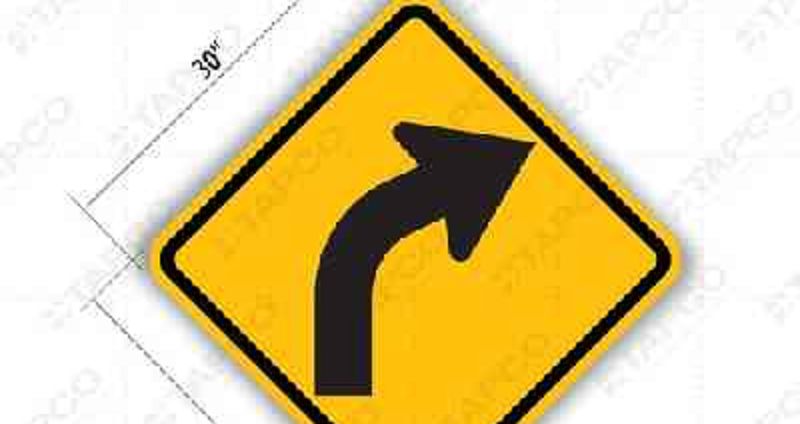
This sign indicates:
Traffic entering from the right
Winding road ahead
Curve right
Concealed intersection on the right
A driver approaching a flashing red traffic light must:
Stop and wait for the flashing green light
Reduce speed and proceed with caution
Stop and proceed only when safe to do so
Stop until the signal light turns green

This sign indicates:
Do not enter
Slow moving vehicles ahead
Warning, Yield sign ahead
Warning, traffic is approaching
According to the law in Alberta, it is the driver’s responsibility to ensure that all passengers under what age are properly restrained in the vehicle?
18 years
24 years
21 years
16 years
When parallel parking, the vehicle’s wheels closest to the curb must be within what maximum distance?
80 centimetres from the curb
30 centimetres from the curb
10 centimetres from the curb
50 centimetres from the curb
Who is responsible and legally obligated to report any medical condition, change in health, or physical disability that may affect a driver’s ability to drive
The driver’s employer
The driver
The driver’s doctor
The driver’s insurance company

This sign indicates:
Road narrows, left
Two-way traffic
Divided highway ends
Obstruction – keep left

This sign indicates:
Rumble strips
Construction zone
Bump
Pavement ends
26.Under the Graduated Driver Licensing program, what is the minimum amount of time that a person must serve as a probationary Class 5 driver?
6 months
18 months
2 years
1 year
A large “X” painted on the pavement indicates:
Construction ahead
The traffic lane is ending
Railway crossing ahead
Wild animal crossing ahead
28.A driver is required to report all collisions to the police when persons have been injured or killed, or when combined damage to all vehicles or property is more than:
$750
$1000
$250
$500
When a driver is stopping behind another vehicle in traffic:
Remain a minimum of 10 metres from the vehicle ahead
Allow sufficient space to move into another lane without reversing
Maintain sufficient space as determined by the 2-second rule
Keep back approximately 1 metre from the rear bumper of the vehicle ahead
If another vehicle is following too close, what should a driver do?
Slow down gradually and encourage the other vehicle to pass
Press hard on the brake pedal
Increase speed to 10 km/h above the posted speed limit
Activate the four-way flashers
When recovering from a skid, a driver should:
Accelerate and steer in the opposite direction of the skid
Brake and counter-steer
Steer in the direction the driver wants the front of the vehicle to go
Brake and hold firmly on the steering wheel
A “slow-moving vehicle” sign must be displayed on the rear of any vehicle that normally travels at speeds less than:
50 km/h
40 km/h
70 km/h
60 km/h
A driver attempting to turn left at a steady green traffic light:
Has the right-of-way over oncoming traffic
Must stop before the pedestrian crosswalk line, then proceed
Has the right-of-way over pedestrians
Must not cross the path of an approaching vehicle unless it is safe
A “Weave Zone” is best described as:
A place on a highway where the entrance and exit lanes are close together, and vehicles that are slowing to exit the highway must drive between vehicles that are accelerating to enter the highway
An area on the highway that is used for emergency parking
A place where the highway has a series of curves that require the driver to slow down
A limited access area on a highway where a driver can legally back their vehicle when they miss their exit
A road test will be refused by a driver examiner if:
The vehicle has a seating capacity greater than 7
The vehicle is registered as a farm vehicle
The vehicle is a rental vehicle
The vehicle is not mechanically safe
Is a driver allowed to exceed the speed limit when passing another vehicle?
Only when passing more than one vehicle at a time
Yes, but not more than 10 km/h over the speed limit
Yes, on primary highways only
No, it is never permitted

This sign indicates:
Children playing in residential area
Pedestrian crosswalk ahead
School area
Playground zone
The speed limit in a construction zone must be obeyed:
Only during daylight hours
Only when a flag person is posted nearby
At all times
Only when construction workers are present
In a vehicle that does not have anti-lock brakes, threshold braking refers to:
Applying an even braking force to the point just before the wheels lock, and easing off slightly if the wheels lock
Pumping the brake pedal repeatedly until the vehicle comes to a stop
Releasing pressure on the brake pedal, then reapplying pressure until the wheels lock
Applying enough force to the brake pedal to lock the wheels and keep them locked
When a driver’s vehicle is approached by an emergency vehicle sounding a siren, from any direction on a two-way road, the driver must:
Continue at a reduced speed and allow sufficient space for the emergency vehicle to pass
Turn on their four-way hazard lights
Stop only when the emergency vehicle has difficulty in passing
Drive as close as possible to the right curb or edge of the road and stop
The recommended braking procedure to bring a vehicle to a normal, smooth stop is:
Continually increase brake pressure until the wheels lock
Shift the vehicle into neutral and apply steady pressure to the brake pedal until the vehicle comes to a stop
Pump the brake pedal smoothly until the vehicle stops
Apply brake pressure, ease off slightly just before the vehicle stops, then re-apply sufficient pressure to stop
In Alberta, the law requires that seat belts must be worn:
Only while carrying passengers
Properly at all times
Only when driving at highway speeds
Only when driving in the city
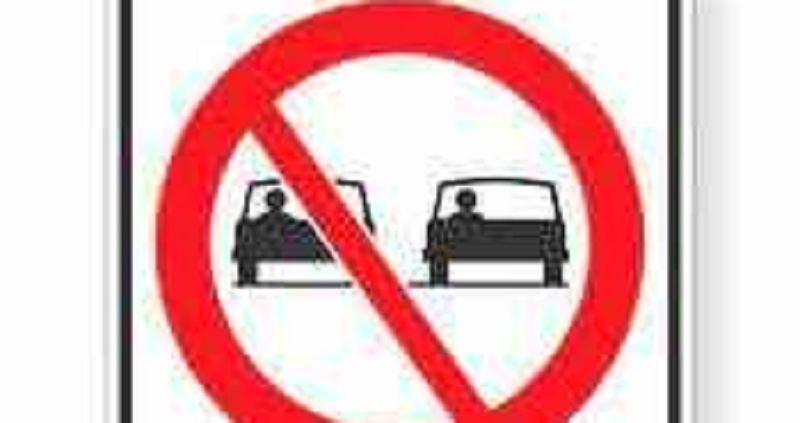
This sign indicates:
Heavy trucks only
Do not pass
No vehicles allowed
Do not enter
A driver entering a traffic circle:
Must yield to traffic on the right
Must yield to vehicles in the traffic circle
Has the right-of-way
Must use the courtesy rule and yield to the vehicle that arrived first
A deceleration lane is:
A lane where vehicles reduce speed when exiting a highway
The right lane of a four-lane highway for use by slower moving vehicles
The lane immediately to the right of a solid yellow line on a highway
A lane on hills for use by slower moving vehicles
When turning left from a two-way road onto a one-way road, what lane should the vehicle enter?
The lane immediately to the right of centre
The lane nearest the curb on the left side of the one-way road
The centre lane of the one-way road
The right lane of the one-way road
When two vehicles approach an uncontrolled “T” intersection at right angles to each other at approximately the same time:
The vehicle on the left must yield the right-of-way
The vehicle on the left has the right-of-way
The vehicle going straight through always has the right-of-way
Both vehicles must stop
Unless otherwise permitted, what lane must a driver be in to turn left from a one-way road?
The lane to the right of centre
The left lane nearest the left curb
The lane closes to the right curb
The centre lane
Which statement describes the steps required to reverse in a straight line?
Keep both hands on the steering wheel and constantly use the inside rear-view mirror for guidance
Place the right hand at the top of the steering wheel, look over the left shoulder and use the outside left rear-view mirror
Place the left hand at the top of the steering wheel and look over the right shoulder through the rear window
Place the left hand at the bottom of the steering wheel and use both outside mirrors
An acceleration lane is:
A lane with broken line markings
A lane on hills, designated for faster moving vehicles
The left lane of a four-lane highway, for use when passing slow moving vehicles
A lane in a merge area for use by vehicles entering the highway

This sign indicates:
Lane ends, loss of right lane
Added lane (free flow)
Curve right
Dual turn lane ahead
52.Under the Graduated Driver Licensing program, a learner with a Class 7 licence is not permitted to drive a vehicle between the hours of:
9:00 A.M. and 5:00 P.M.
Midnight and 5:00 A.M.
10:00 P.M. and 6:00 A.M.
Midnight and 7:00 A.M.
What does a flashing yellow traffic light mean?
The traffic light will turn green
Stop until the light stops flashing
The traffic light will turn red
Proceed with caution
Unless otherwise posted, the school zone speed limits are in effect on school days during the following hours:
8:30 A.M. to 1 hour after sunset
8:00 A.M. to 9:30 A.M., 11:30 A.M. to 1:30 P.M. and 3:00 P.M. to 4:30 P.M.
8:30 A.M. to 9:30 A.M., 12:00 P.M. to 1:00 P.M. and 3:30 P.M. to 4:00 P.M.
8:00 A.M. to 4:30 P.M.
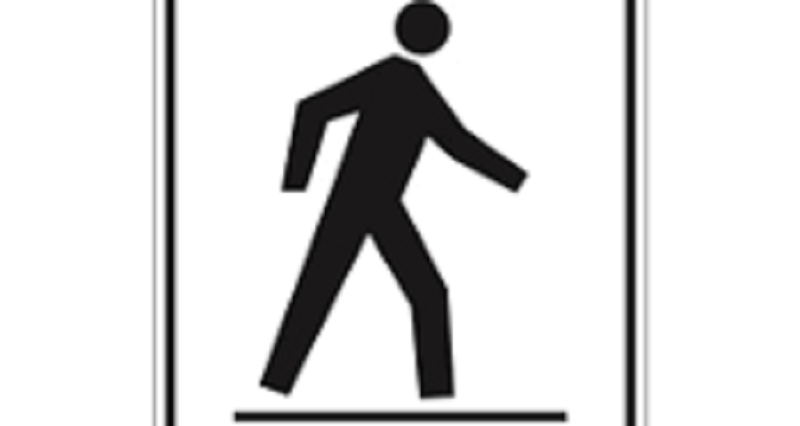
This sign indicates:
Playground zone
Pedestrian crosswalk
Designated school bus stop
School zone
When driving in the right lane on a highway, what should a driver do if another vehicle attempts to merge from an acceleration lane on the right?
Stop to allow the other vehicle in
Accelerate to close any gap in the traffic flow
Move into the left lane if it is safe to do so, or be prepared to adjust speed
Insist that the other vehicle yield the right-of-way
Which direction should a vehicle’s front wheels be turned when parked uphill on a two-way road with a curb?
Parallel to the curb
To the left
To the right
Straight ahead
When approaching the rear of a stopped school bus that has its alternately flashing red lights activated, a driver must:
Sound the horn to alert any pedestrians and pass at a slow rate of speed
Stop behind the bus and wait until the alternating red lights stop flashing
Move to the left lane, reduce speed to 30 km/h and pass cautiously
Stop behind the bus, look carefully for pedestrians and, if clear, drive past the bus slowly
When travelling in urban areas, drivers should scan the road approximately:
25 to 30 seconds ahead
12 to 15 seconds ahead
20 to 30 seconds ahead
1 to 6 seconds ahead

This sign indicates:
T intersection
Traffic lane ends
Concealed intersection
Trucks entering highway ahead

This sign indicates:
Winding road ahead
Weave zone ahead
Slippery when wet
Lane changing permitted
Before leaving a parallel parking space on the right side of a road:
Turn on the right signal
Shoulder check to the left
Shoulder check to the right
Use an arm signal straight out and up
When approaching the top of a hill on a two-lane highway:
Exceeding the speed limit is permitted
Flash the headlights to warn oncoming vehicles
Stay to the right portion of the lane
Keep close to the centre line to prevent others from passing
Playground zones are in effect:
From 8:30 A.M. to 1 hour after sunset
From 8:00 A.M. to 8:00 P.M.
During daylight hours and until 11:00 P.M.
Only when school lets out at noon and after 4:30 P.M.

This sign indicates:
�T” intersection
Winding road ahead
Merging traffic
Road narrows to the right
According to the Basic Licence Driver’s Handbook, most skids are the result of:
Bad brakes
Icy roads
Bad tires
Driver error
How close can a driver legally park a vehicle to a Stop sign?
10 metres
5 metres
3 metres
1.5 metres
Parking in a space reserved for persons with disabilities is permitted:
When all other parking spaces are filled
While the driver is waiting in the vehicle
When a driver stops for less than 5 minutes
When the vehicle has a proper identifying placard or licence plate
At what minimum distance must headlights be dimmed at night when approaching another vehicle from behind?
60 metres
300 metres
150 metres
100 metres
When are dual turns permitted at an intersection?
Only when turning from a one-way road onto a one-way road
Only when indicated by pavement markings or traffic control signs
Any time there are at least 2 lanes on the road being entered
Only when the road has 6 or more lanes

This sign indicates:
Through lane only
Passing permitted
No turns permitted
Two-way traffic
Under the Graduated Driver Licensing program, a learner with a Class 7 operator’s license is suspended when they accumulate:
15 demerits
12 demerits
8 demerits
7 demerits
Speed limit signs indicate:
The speed you The minimum speed permitted on all highwaysshould travel under all driving conditions
The maximum speed permitted when conditions are favourable
The maximum speed permitted except when passing
The minimum speed permitted on all highways
An “uncontrolled intersection”:
Has a flashing yellow light for one direction of traffic and a flashing red light for the other direction of traffic
Has traffic signs but no traffic control signal lights
Has no traffic control signal lights or traffic signs
Has Yield signs but no Stop signs

This sign indicates:
Sharp left curve in the road ahead
Left turns are prohibited
Vehicles may turn left or go straight
Double lane left turn
When facing a Merge sign a driver should:
Stop at the entrance to the other highway and wait until a gap in traffic occurs before proceeding
Watch for a gap in traffic on the highway they are entering, adjust to highway speed in the acceleration lane and blend in smoothly
Stop and yield the right-of-way to traffic already on the highway
Reduce speed and proceed with caution
In reduced visibility due to fog, smoke or snow, use the:
Park lights
Headlights on high beam
Headlights on low beam
Daytime running lights
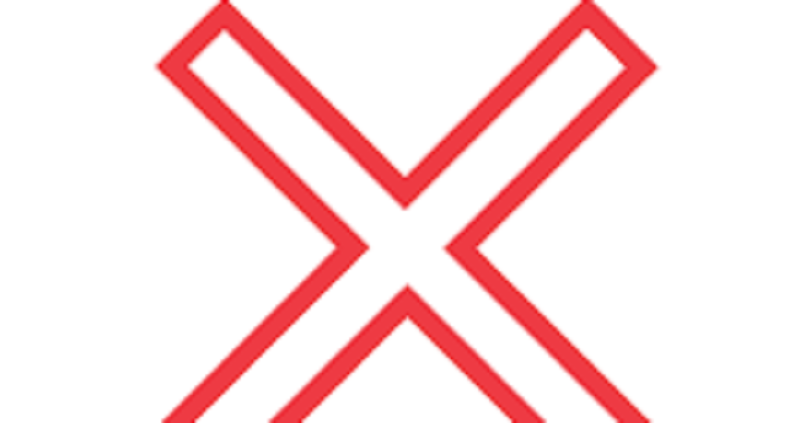
This sign indicates:
Emergency vehicles entering roadway
The designated lane is closed
Railway crossing
Do not enter
Is a driver allowed to turn right at a red traffic control light?
Yes, but only when a sign permits such a turn
Yes, if the driver reduces speed and there is no traffic or pedestrian in the intersection, and no sign that prohibits such a turn
Yes, if the driver stops and there is no traffic, pedestrian or sign that prohibits such a turn
No, right turns on a red traffic light are never permitted

This sign indicates:
Lane is reserved for use by the specified vehicles
One-way traffic only
Car pool vehicles only
Lane can be used for dangerous goods vehicles
When a vehicle is stopped to allow a pedestrian to cross the road, other vehicles that are approaching from the rear:
May pass the stopped vehicle if there is no oncoming traffic that may impede passing safely
Must not pass the stopped vehicle. It is illegal
May pass the stopped vehicle when eye contact is made with the pedestrian and the pedestrian stops
May pass the stopped vehicle when the pedestrian crossing signal has changed to “Don’t Walk”
When a head restraint is raised to the proper position, the centre of the head restraint is:
Level with the top of the ears
Level with the top of the shoulders
Level with the neck
Level with the top of the head

This sign indicates:
School zone ahead
Caution log trucks turning
Traffic control signal advance warning
Pedestrian crosswalk ahead
When a “PASSING LANE AHEAD” sign is posted, the driver of a slower moving vehicle should:
Use the right lane and reduce their speed to half the posted speed limit
Use the left lane only
Increase speed
Move into the right lane when safe
When approaching the rear of a school bus that is displaying alternating flashing amber lights, a driver should:
Be prepared to stop as this is a warning that the alternating flashing red lights will come on once the bus has stopped
Be prepared to stop as this could be a warning that there is a collision ahead and the traffic flow has stopped
Stop immediately because the school bus is loading or unloading students
Use caution as the school bus is approaching a railroad crossing and is about to stop
In the Basic Licence Driver’s Handbook, “nighttime” is defined as the period of time:
Beginning 1 hour before sunset and ending 1 hour after the following sunrise
Beginning at sunset and ending at the following sunrise
Between 7:00 P.M. and 7:00 A.M.
Beginning 1 hour after sunset and ending 1 hour before the following sunrise
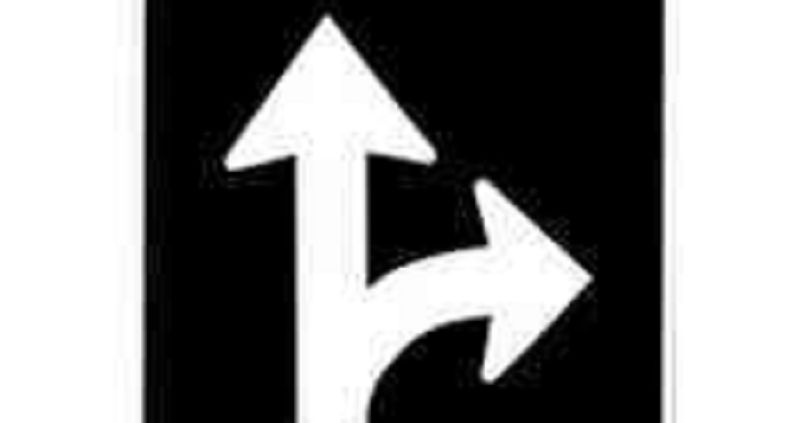
This sign indicates:
No through traffic or right turns
Turn left or go straight through
Turn from a one-way road onto a one-way road
Straight through or right turn
A vehicle exiting a parking lot onto a roadway:
Must stop only if there is a Stop sign
Must come to a complete stop
Must stop before crossing the sidewalk only if there are predestrians present
Is not required to stop
When approaching a railway crossing that has the flashing red light and bell activated:
Cross the tracks if the train is a minimum of 250 metres away
Reduce speed, check for trains, and then proceed across the tracks
Do not stop and do not change gears while crossing the tracks
Stop at least 5 metres from the nearest rail until the train has passed
The recommended method for travelling through a curve on a highway is:
Reduce speed before the curve, stay in the lane and gently accelerate after entering the curve
Maintain speed before the curve, brake in the curve, look ahead and accelerate out of the curve
Cover the brake pedal before the curve, counter-steer toward the outside of the lane and accelerate when exiting
Accelerate before the curve, cover the brake pedal in the curve and accelerate after leaving the curve

This sign indicates:
Yield the right-of-way to pedestrians and traffic
Dangerous goods vehicle placard: flammable gas
Slow moving vehicle
Warning, Yield sign ahead
Why is it not safe to pass a loaded log-haul truck that is turning?
The driver of the truck needs to fully concentrate on the turn and does not need the added responsibility of a passing vehicle
Loaded log-haul trucks obey the 6-second rule for turns
A danger zone exists as the overhang of the logs from the tail end of the truck could block all the lanes on a highway during the turn
It is illegal to do so

This sign indicates:
Playground zone ahead
Pedestrian crossing ahead
School bus stop ahead
School zone ahead
When encountering a funeral processions that is crossing an intersection:
Sound the horn before proceeding
Proceed through the funeral procession only when there is sufficient space between vehicles
Yield the right-of-way and do not break through the procession
Flash the high beam headlights before proceeding
If the vehicle’s right tires travel off the paved portion of the roadway:
Apply the brakes and counter-steer to return to the paved portion of the roadway
Keep a firm grip on the steering wheel, ease off the gas pedal, and then gradually return to the paved portion of the roadway
Accelerate slightly, then turn the steering wheel sharply to return to the paved portion of the roadway
Move the vehicle completely off the paved portion, then steer back onto the paved portion of the roadway

The sign indicates:
A school zone
School crosswalk ahead
Playground zone
Pedestrian activated lights ahead
When completing an angle park, the vehicle’s front wheel must be within what maximum distance from the nearest curb?
100 cm
50 cm
25 cm
75 cm
In an urban area, when a pedestrian is standing at a crosswalk with their arm raised at approximately right angles to their body and pointing to the opposite curb, what does this mean?
Drivers must stop and yield to the pedestrian
The pedestrian is visually impaired and needs assistance to cross the road
Drivers do not have to yield to the pedestrian until they step off the curb
Drivers should reduce speed to 20 km/h and be cautious when passing the pedestrian
In an urban area, when a pedestrian is standing at a crosswalk with their arm raised at approximately right angles to their body and pointing to the opposite curb, what does this mean?
Drivers must stop and yield to the pedestrian
The pedestrian is visually impaired and needs assistance to cross the road
Drivers do not have to yield to the pedestrian until they step off the curb
Drivers should reduce speed to 20 km/h and be cautious when passing the pedestrian

This sign indicates:
Pavement ends
Construction zone ahead
Dead end
Hazard marker

This sign indicates:
Divided highway ends
Divided highway begins
Obstruction – pass on the left
Two-way traffic
When approaching an intersection displaying a steady yellow traffic light:
Proceed since the light is about to turn green
Yield to vehicles on the right
Stop before the intersection unless the stop cannot be made in safety
Increase speed to clear the intersection
A solid yellow line together with a broken yellow line marked on the centre of a highway means:
The road narrows ahead
If the solid line is on your side, passing is permitted
If the broken line is on your side, passing is not permitted
If the broken line is on your side, passing is permitted
At 9:00 A.M. On a school day, what is the maximum speed permitted in a school zone in a rural area, unless otherwise posted?
50 km/h
20 km/h
40 km/h
30 km/h
{"name":"Alberta Basic Licence Drivers Assessment", "url":"https://www.quiz-maker.com/QPREVIEW","txt":"Test your knowledge with the Alberta Basic Licence Drivers Assessment Quiz! This quiz is designed to help you review essential driving rules and regulations specific to Alberta. Whether you're preparing for your driver’s test or just want to brush up on your driving skills, this quiz is a great resource.Key Features:30 carefully crafted questionsMultiple choice formatInstant feedback on your answers","img":"https:/images/course1.png"}
More Quizzes
Driver's Test Practice!
13634
Drivers Test 2022
14735
ʰ�만에 OX퀴즈
20100
Grandparent and Grandchild Connection Quiz
8414
Which Football Club Should I Support? Champions League
201016642
Oxford Questions - Oxford University Trivia (Free)
201017123
Which Harry Potter Girl Are You? Take the Free
201017783
Am I Japanese? Free - Find Your Persona in Japan
201017511
Christian Personality - Find Your Biblical Role (Free)
201016700
Commutative Property Practice Problems - Free
201016252
Fraction: Greater or Less Than (Free Practice)
201017186
COD Zombies - Black Ops Storyline Challenge
201019345